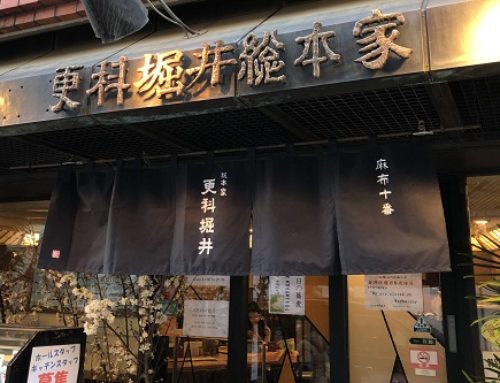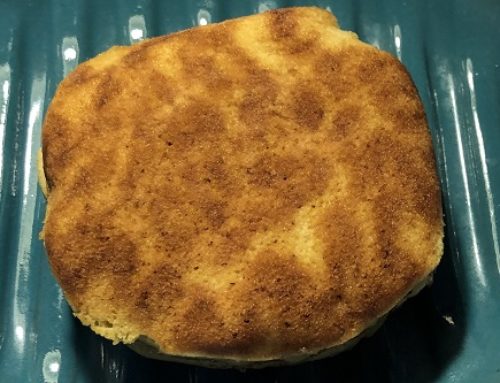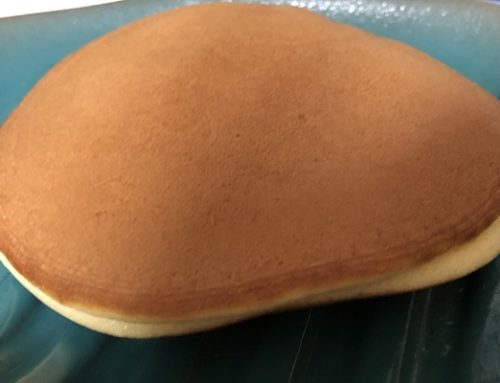Dorayaki is very popular wagashi (Japanese sweets) in Japan. But I guess few people from abroad know Dorayaki.
What’s Dorayaki?
Dorayaki is a type of wagashi (Japanese sweets) that “Anko” (red bean paste) is sandwiched between two pancake-like buns. Buns resemble castella (Japanese style sponge cake).
If you had watched TV anime series “Doraemon”, the food Doraemon loves is Dorayaki.
Bunmeidō (big company as confectioner) sells Dorayaki named “Mikasa-yama (yama means mountain)”. And you could buy it at almost every department stores (mostly on basements). Though there are six companies named Bunmeidō (like Bunmeidō-honten, Bunmeidō-Tokyo etc. the same origin) that sell Mikasa-yama and tastes are a little different, but in my opinion, Bunmeidō’s Mikasa-yama has become the standard for Dorayaki. Besides Bunmeidō’s Mikasa-yama, you could buy Dorayaki in many cities and towns. But these Dorayaki are resemble Bunmeidō’s Mikasa-yama in their sizes and appearances.
Kamejū’s Dorayaki
There are the three most famous stores for Dorayaki. But some add one more store and call them the four most famous stores for Dorayaki. One is Kamejū. The others are Usagi-ya, Sōgetsu, and if we add one more, Seiju-ken.
Kamejū at Asakusa
Although Kamejū at Asakusa sells various wagashi, it is especially famous for its Dorayaki. And the store boasts that its ranking is the first in Japan.
The store is located near Kaminari-mon (2-18-11 Kaminari-mon, Taitō-ku). If you get out of Exit 2 of subway station Asakusa (Ginza line of Tokyo metro, Toei Asakusa line) and walk straight ahead, you would soon find out the store on your left. The store faces on Kaminari-mon-dōri. It opens 10:00 – 20:30. Closing date is indefinite.

Kamejū
In above picture, you could see customers form a line in the store. When I saw Kamejū store for the first time, I thought the store was crowded, but not so much. However my guess was completely wrong. The customers waited in line outside of the store on the sidewalk along Kaminari-mon-dōri. As the line began from near the bus stop, I thought at first they were waiting for a bus. But the truth was they waited for entry to the store.
Why do the customers make a line to buy Dorayaki? Main reason is simply demand exceeds supply. Kamejū makes 3,000 Dorayaki a day. As the number is limited, Dorayaki might happen to be sold out before noon or in the early after noon. One day I visited there around 11:30 am. At that time, an employee said that as the stock of Dorayaki is low, you might not be able to buy them if the customers in front of you would buy in large volume. When I passed by the store at 13:30 on the same day, the store already closed.

Kamejū closes in the early afternoon
Appearance of Kamejū’s Dorayaki
Price of one Dorayaki is 360 yen. And I think it is the most expensive Dorayaki in Japan. Kamejū only accepts cash.

Kamejū’s Dorayaki with wrapping
Kamejū’s Dorayaki is very large. It’s about 110 mm in diameter. Its size is much larger than Bunmeidō’s Mikasa-yama.

Dorayaki without wrapping
In above picture, you can see there are many crater-like holes on the surface of toasted batter of Dorayaki. I infer artisans of Kamejū whiped egg whites well for making batter. Artisans intentionally get air in the batter. That is the reason to produce crater-like holes on the surface of toasted batter. The artisans toast batter by hand.
Ingredients of Dorayaki are sugar, flour, egg, “dainagon azuki” (they are larger than ordinary azuki (red beans)) and raising agent. As it doesn’t use artificial preservatives, its effective period for eating is three days.
Tastes of Kamejū’s Dorayaki
As there is no place to eat in the store or around the store, if you buy Dorayaki, you have to bring it back to your hotel or may eat it on a bench in the precinct of Sensō-ji (Sensō temple).
The first time I ate Kamejū’s Drayaki, though batter was soft, I felt batter tasteless and “anko” (red bean paste) too sweet. But after eating it several times, my impression on it changed. Anko is “tsubuan” and matches batter of Dorayaki. In tsubuan, form of red bean remains. Kamejū calls this anko “kuro an” (black an). Kamejū also sells Dorayaki with “shiro an” (white an). “Shiro an” is made from white kidney bean.
Objectively amount of red bean paste is small comparing to large batter, but when we eat and taste Dorayaki, it seems balance of red bean paste and batter is superb. Batter is soft and moist. I’ve never eaten such soft and moist batter. Some say batter is soft like a sponge cake. Others say it’s soft like a chiffon cake.
Although price of Dorayaki is quite expensive comparing to other stores, I think it has value for its price.
Besides Dorayaki, steamed bread with small amount of red bean paste called “Matsukaze” sells well. Steamed bread contains “kokutō (brown sugar or raw sugar)” as ingredient.
Location of the store is far better than the other three famous stores for Dorayaki, because when you visit Asakusa, you could drop by while you are there. The downside is you have to wait to buy Dorayaki. How long you have to wait differs day to day. But I think probably most of the time you could buy it within 30 minutes, if it’s not sold out.






Leave A Comment